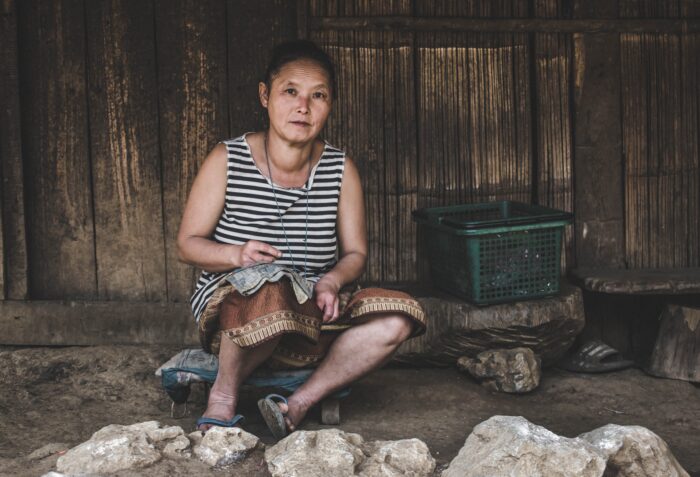Is Blockchain the Answer to Supply Chain Transparency?
By Camille Mori
Blockchain is a buzzword that gets thrown around a lot, it seems to be the answer to everyone’s problems. The technology is often associated with cryptocurrencies like bitcoin, but can have many other applications as well. It essentially decentralizes transactions by taking out the middleman and replacing them with a secure digital record. Wikipedia’s definition is “a decentralized, distributed and public digital ledger that is used to record transactions across many computers so that the record cannot be altered retroactively without the alteration of all subsequent blocks and the consensus of the network.”
![]()
After a semester of researching technology innovation in the apparel supply chain and what blockchain could mean for the garment industry, I truly believe it could revolutionize the industry, as long as it’s done right. Imagine picking up a sweater in a store and scanning a code to know exactly how much the garment worker made and if that is a fair wage, or the specific location of the mill that produced the yarn and if it’s sustainable.
There are some innovative brands that are implementing blockchain technology to bring more transparency to their supply chains, but to be done on a larger scale there are a few steps that the industry has to take in order to be ready for when the technology is developed. I have identified four initiatives that need to happen simultaneously in order to create a sector where blockchain transparency tools can make an impact: clean data entry, renewable energy to power the chain, policies and shared responsibility models, and talent to program the technology for the garment industry.

Photo by Quinn Buffing on Unsplash
Clean data entry
First and foremost we must focus on collecting accurate data that can be input into the system. Although the blockchain itself is secure, if the data going into it is corrupt then keeping it secure will be futile. There are several reasons why collecting clean data is challenging along the apparel supply chain, from unknown subcontractors to deceitful factory owners. This is exactly why it has become commonplace for factories to exploit their workers, the lack of accountability and regulations allows them to slide under the radar. The logistics of how to collect data need to be explored before bringing in a new blockchain system. Who will you ask about wages and working standards? How can we overcome the problem that auditors face now, such as only seeing a snapshot of how factories operate? How do you avoid seeing this rosy picture that factory owners want you to see?
GoodWeave has starting to navigate the process of collecting the most accurate data possible to digitize the rug making supply chain in India in order to ameliorate child labor. Through their system, they are training factory owners to learn to work with them on compliance issues and work to improve while tracking their progress through a digital interface in order to create real-time reports. It’s important to note that they chose not to use blockchain, mainly because of the difficulty of collecting clean data. A lot of the discrepancies lie in human error or potentially lack of trust between surveyor and factory owner. It takes time to develop these relationships and train workers to input what they find. As we form deeper relationships with factories and brands, the idea of digitizing the apparel supply chain on the blockchain comes closer to reality.

Photo by Jason Blackeye on Unsplash
Energy to power the chain
One of the biggest downfalls of blockchain technology is the energy used to store the chain. Since a lot of garment production takes place in developing countries where not everyone has energy in their own homes, powering this blockchain proves to be very challenging and ethically complicated. Establishing a system for sustainable energy are key to making sure the technology does not tax the energy sources in garment producing countries.
Additionally, engineers are simultaneously racing to build new algorithms for the technology. Currently, creating the hash (which is a unique code that stores the data) takes up an unbelievable amount of energy. By engineering new ways to set up the blockchain so it doesn’t have to go through this process, developers could create a much greener system with potential for scale. Researchers from top universities and organizations are working on solutions to this problem, hopefully, we will soon have an answer to help us move forward.

Photo by The Climate Reality Project on Unsplash
Policies and shared responsibility models
Laws and regulations cannot force the industry to change just by being implemented, however, they help guide governments and organizations in the right direction. As policies are created and implemented effectively, brands slowly start to shift as they adjust to the new landscape. Recently there has been a push for shared responsibility multi-stakeholder agreements, and I think they are essential to building the framework to move the industry forward.
As we saw with the California Transparency in Supply Chains Act (USA) and the Modern Slavery Act (UK), companies start to change their behavior when they are held accountable for their actions around the world. That being said, both of these laws have been criticized for not going far enough to protect people from forced labor in supply chains. There is still a long way to go, and it’s important for advocacy groups like Fashion Revolution to keep this top of mind and on the agenda for elected officials.
Shared responsibility models help to keep all the gears moving, from businesses to NGOs, in curing the world of fast fashion. Many of these shared responsibility models are still in their nascency, but they have already scored some wins. These collaborations between brands, governments, factory owners, nonprofits and NGOs create an equal playing field for the apparel industry to come together on global issues such as environmental sustainability or human rights abuses. They also serve as a guiding hand in setting the parameters for factory compliance and strategy for making sure garment workers are not exploited.

Photo by Émile Perron on Unsplash
Talent to develop a blockchain for the industry
Since blockchain is a new technology, there is a rather small talent pool to draw from. Furthermore, a lot of the research and development is happening in the fintech space due to the early successes of bitcoin and other cryptocurrencies. It will be hard to sway software developers to create technology for industries that may have smaller budgets than the finance industry. This is a common issue in the nonprofit and international development space and would also cause a problem in the fashion industry, where technology development budgets are not necessarily large
It would be smart for brands and governments with strong garment sectors to attract talent from local universities to conduct research with them or sponsor case competitions to attract students to brainstorm ideas to their biggest hurdle implementing blockchain technology in the garment industry. Over time the talent pool will grow, hopefully, people will be attracted by the complexity and challenge of reducing forced labor in the supply chain with blockchain.
So far blockchain has been used in shipping garments and with small scale apparel companies. It will help the industry to simplify and speed up shipping times, and it’s great that smaller companies are being innovative in their use of technology, but if we want to see industry wide change we need to start with large scale adoption of a standardized system for brands. Once we create the framework for this and bring regulation and visibility to factories and subcontractors, blockchain could prove an amazing tool to transfer that information quickly and have it available to the general public.
In effect, blockchain allows for the decentralization of trust. With all of this information cataloged and public, brands won’t have to wonder if their clothes are being in the factories they’re communicating with or subcontracted out to substandard factories and the consumer will no longer have to worry about where their clothes come from.





